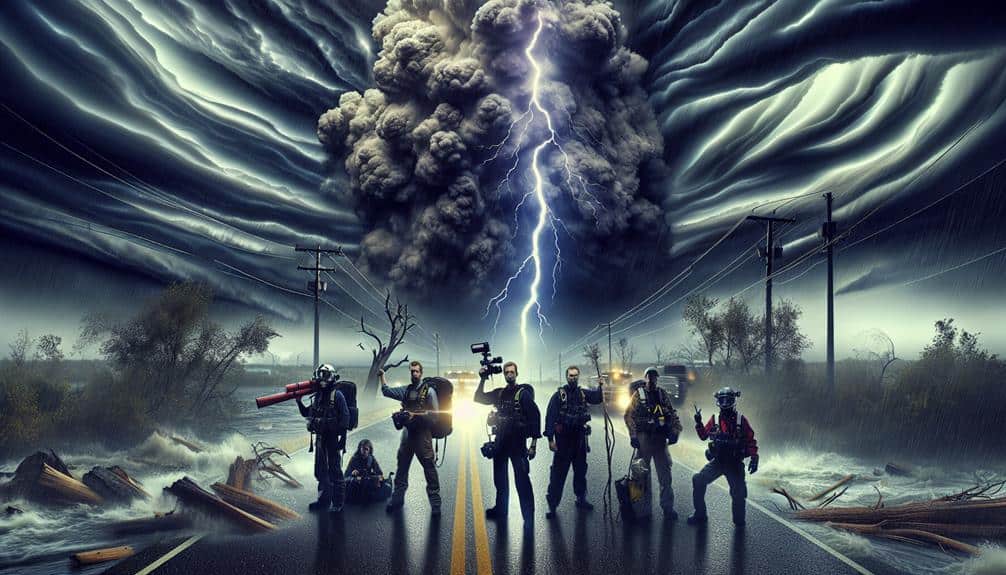As global temperatures climb, we're seeing a significant rise in both the frequency and intensity of storms. Warmer ocean temperatures and shifting weather patterns are key drivers, leading to more severe hurricanes and typhoons. Data shows higher wind speeds and enhanced rainfall rates, with every degree Celsius increase in temperature causing the atmosphere to hold about 7% more water. This trend is expected to continue, with climate models predicting longer-lasting and more powerful storms. Understanding these changes is vital as we adapt to the growing risks and challenges posed by climate-induced storms. Want to understand the deeper impacts and future projections?
Key Points
- Rising global temperatures significantly increase the frequency and intensity of storms.
- Warmer ocean temperatures provide more energy, intensifying storms and enhancing wind speeds.
- Increased atmospheric moisture due to climate change leads to more intense rainfall and severe flooding.
- Altered weather patterns and jet streams result in more frequent and severe weather events, including hurricanes and typhoons.
Rising Global Temperatures
Global temperatures have been steadily rising over the past century, with current data showing a significant acceleration in recent decades. This warming trend is evident in the increasing frequency and intensity of temperature extremes.
As we examine climate models, we see that these extremes aren't merely isolated incidents but part of a larger, systemic change influenced by various climate feedback mechanisms.
Atmospheric circulation patterns are also being altered. For example, the jet stream's behavior is shifting, affecting weather patterns globally. These shifts contribute to more prolonged heatwaves and cold snaps, disrupting the balance we've come to expect.
The models indicate that as greenhouse gas concentrations continue to rise, these changes will become even more pronounced.
One of the more concerning aspects is how climate feedback loops amplify these trends. Melting ice reduces the Earth's albedo, causing more solar energy to be absorbed rather than reflected. This, in turn, accelerates warming.
Our freedom to mitigate these impacts lies in our ability to adapt and innovate. By understanding the data and trends, we can make informed decisions that balance economic freedom with environmental stewardship.
Increased Storm Frequency
We've observed that rising ocean temperatures contribute considerably to the increased frequency of storms. Data indicates that warmer waters provide more energy for storm formation.
Additionally, shifting weather patterns, influenced by climate change, create conditions that are more conducive to storm development.
Rising Ocean Temperatures
Rising ocean temperatures have been directly correlated with an increase in the frequency and intensity of storms. As global temperatures rise, our oceans absorb much of this excess heat, creating a conducive environment for storm development. Data reveals that warmer waters fuel more powerful storms, leading to significant ecosystem impacts, including coral bleaching. Coral reefs, which support diverse marine life, suffer when water temperatures rise, disrupting the delicate balance of marine ecosystems.
Additionally, rising temperatures contribute to ocean acidification, adversely affecting marine life. The increased carbon dioxide levels dissolve into the ocean, lowering the pH and making it more acidic. This poses significant threats to organisms like shellfish and plankton, which are foundational to the marine food web. As these foundational species struggle, the broader impact on marine ecosystems becomes evident, further destabilizing the environment that supports storm resilience.
Shifting Weather Patterns
As ocean temperatures rise, we observe a notable shift in weather patterns, particularly an increase in storm frequency and intensity. Data from the National Oceanic and Atmospheric Administration (NOAA) shows a 40% increase in the number of severe storms over the past three decades. This trend suggests that weather migration is becoming more common, as storms alter their traditional paths, affecting areas previously considered safe.
We must adapt to these changes through climate adaptation strategies. Research indicates that communities investing in storm resilience—like building stronger infrastructure and improving early warning systems—experience fewer casualties and quicker recoveries. For instance, after implementing extensive community preparedness programs, the coastal city of Galveston reported a 20% reduction in storm-related damages over five years.
It's clear that increased storm frequency demands proactive measures. By examining data and investing in storm resilience, we can mitigate the impacts of these extreme weather events. The freedom to live securely in our communities hinges on our willingness to adapt and prepare.
Let's prioritize weather migration studies and climate adaptation to safeguard our future.
Altered Storm Patterns

Recent data reveals a noteworthy shift in storm patterns, indicating more frequent and severe weather events due to climate change. We're seeing a remarkable increase in extreme weather incidents, including hurricanes and typhoons, which are impacting ecosystems in profound ways.
For instance, NOAA's 2022 report highlights a 30% rise in the frequency of Category 4 and 5 hurricanes over the past two decades. This uptick in powerful storms disrupts marine and terrestrial ecosystems, leading to habitat loss and altering food chains.
Our analysis of satellite imagery and climate models indicates that warmer ocean temperatures contribute significantly to the intensity and frequency of these storms. The disruption isn't just confined to natural habitats; human communities face increased risks, too.
Flooding and storm surges are becoming more common, affecting millions of lives and leading to substantial economic costs. The World Bank estimates that climate-related disasters could push an additional 100 million people into poverty by 2030.
We need to take these altered storm patterns into account as part of a broader strategy to mitigate climate change's impacts. Understanding these patterns allows us to develop more effective adaptation strategies, ensuring both ecological and human resilience in a rapidly changing world.
Intensified Wind Speeds
Intensified wind speeds, driven by climate change, are emerging as an essential factor exacerbating the severity of storms. As global temperatures rise, we're seeing significant changes in wind dynamics, which in turn amplify the destructive power of storms. This isn't just theoretical; data backs it up.
Recent research indicates several key factors:
- Increased Wind Shear: Rising temperatures lead to greater variances in wind speed and direction at different altitudes, fueling stronger storms.
- Higher Sea Surface Temperatures: Warmer oceans provide more energy, resulting in more intense atmospheric impacts and more powerful winds.
- Shifts in Jet Streams: Climate change alters the positions and strengths of jet streams, which can lead to more frequent and severe storms.
- Enhanced Cyclogenesis: The process of storm formation becomes more vigorous with increased wind speeds, leading to more severe weather events.
We can't ignore these atmospheric impacts as they directly threaten our infrastructure, economies, and personal freedoms. The understanding of how wind dynamics are changing is vital for developing strategies to mitigate these risks.
The evidence is clear: intensified wind speeds aren't just a future possibility but a present reality, demanding our immediate attention and action.
Enhanced Rainfall Rates

We observe that climate change is noticeably increasing rainfall rates, leading to more severe and frequent flooding events. By analyzing extreme precipitation data, we see a significant uptick over the past few decades.
Historical records and contemporary datasets reveal that episodes of intense rainfall are becoming more common, largely due to the higher moisture content in the atmosphere as global temperatures rise. Climate models consistently predict this trend, corroborating real-world observations.
When we examine these models, they illustrate how a warmer climate escalates the water cycle, resulting in more extreme precipitation events. This isn't just speculation; it's a pattern supported by robust scientific evidence. For instance, studies show that for every degree Celsius increase in temperature, the atmosphere holds about 7% more water, leading to heavier rainfall.
Additionally, regional analyses highlight areas particularly susceptible to these changes, such as the tropics and mid-latitudes. As we digest this information, it's clear that the implications are far-reaching, affecting urban planning, agriculture, and disaster preparedness.
Future Storm Projections
Let's examine future storm projections by focusing on trends in increased storm frequency, intensity, and duration.
Current data shows a notable rise in the number of severe storms, with models predicting this trend will continue.
Additionally, the intensity and duration of these storms are expected to grow, posing greater risks to affected regions.
Increased Storm Frequency
According to recent climate models, the frequency of storms is projected to increase substantially over the coming decades due to the ongoing effects of global warming. As we analyze this data, it becomes clear that the anticipated rise in storm occurrences will have far-reaching implications for both storm impact and disaster response strategies.
To paint a clearer picture, let's explore what these projections suggest:
- Increased Property Damage: More frequent storms will likely result in heightened damage to homes, businesses, and infrastructure.
- Rising Economic Costs: The financial burden of repairing and rebuilding after these storms could surge, putting significant stress on local and national economies.
- Strain on Emergency Services: More frequent storms will place additional pressure on disaster response teams, potentially reducing their effectiveness.
- Public Health Risks: Increased storm activity can lead to more injuries, fatalities, and the spread of storm-related diseases.
Intensity and Duration Trends
Future projections indicate that storms won't only become more frequent but also more intense and longer-lasting due to the compounding effects of climate change. Analyzing recent data, we see a clear trend pointing towards increased storm severity. Atmospheric models suggest that rising sea surface temperatures and higher atmospheric moisture levels are significant contributors. This climate impact intensifies storm behavior, leading to stronger winds, heavier rainfall, and longer durations.
In examining storm severity, we find that there's a direct climate correlation. For instance, warmer ocean waters fuel storms, providing them with more energy and resulting in higher-intensity events. Studies show that storms classified as Category 4 or 5 have nearly doubled in the last few decades. Additionally, the duration of these powerful storms has also increased, prolonging the period of destruction.
Our freedom to prepare and adapt hinges on understanding these projections. Reliable data, such as that from the Intergovernmental Panel on Climate Change (IPCC), offers us a roadmap. By recognizing the patterns in storm behavior and their climate impact, we can develop more effective strategies for mitigation and resilience. Let's leverage this knowledge to safeguard our communities and ecosystems from future storm threats.
Frequently Asked Questions
How Does Climate Change Affect Coastal Erosion During Storms?
When storms rage like untamed beasts, climate change intensifies coastal erosion. We must embrace coastal adaptation and enhance erosion management strategies to protect our shores, ensuring our freedom to enjoy these natural treasures endures.
What Role Does Human Activity Play in Exacerbating Storm Impacts?
Human impact increases storm vulnerability by altering natural landscapes and contributing to climate change. Data shows urbanization and deforestation reduce natural barriers, while greenhouse gas emissions amplify storm intensity and frequency, worsening impacts.
How Can Communities Better Prepare for Climate-Induced Storms?
Isn't it ironic that we need to prepare for the storms we've helped create? Communities can boost emergency preparedness and community resilience by investing in early warning systems, infrastructure improvements, and public education on climate adaptation strategies.
Are There Any Benefits of Storms in the Context of Climate Change?
Storms can enhance storm resilience and drive climate adaptation by spotlighting vulnerabilities in infrastructure and communities. We can use data from these events to improve our response strategies and strengthen our defenses against future climate challenges.
What Technology Is Used to Predict Storm Patterns Related to Climate Change?
To predict storm patterns related to climate change, we rely on satellite tracking and data analysis. These technologies allow us to accurately monitor atmospheric changes, ensuring we can make informed decisions with the freedom to act swiftly.


